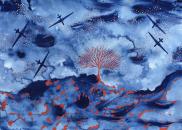 845505616680547938.jpg
845505616680547938.jpg
 845505616680547938.jpg
845505616680547938.jpg
This issue of AWBR, contains nine long-form reviews of recent books by Australian women writers. The focus of Carole Ferrier's editorial essay is on the potential destructive effects of new technologies - such as drones - on animals and the environment. The cover image for this issue - The Tree-of-Life Sends its Energy Underground - is an evocative painting by visual artist Kathryn Brimblecombe-Fox. She provides a detailed explanation of her inspiration of this piece from her 'Dronescapes' series.
Only literary material by Australian authors and within AustLit's scope individually indexed. Other material in this issue includes:
Kathryn Brimblecombe-Fox’s painting, on this cover of the AWBR, from her “Dronescapes” series, encourages meditation upon the application of technological advances, specifically within the history of warfare. It depicts militarised drones— machines that deliver weapons. Their deployment for targeted attacks in remotely controlled strikes has developed and increased over time since the second Gulf War. During the presidency of Barack Obama, counter-insurgency airborne drone measures in undeclared battlefields purported to minimise civilian casualties. However, these strikes have given rise to urgent questions about the identification of terrorists, since any male close to a target can fall into the category of “terrorist,” whereas a female or a child in the vicinity is less likely to be categorised in this way. Other justifications for this style of drone warfare are that they can prevent planned attacks on local populations, and save the lives of American warfighters or others from the “free world” who may have their “boots on the ground” near the target or “kill zone.” The remote nature of drone operation also removes pilots from possible harm or death, thus minimising American citizenry concerns about sending troops to fight and die in distant wars.' (Introduction)